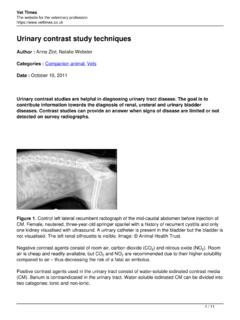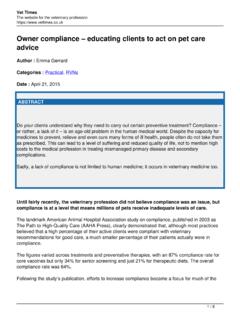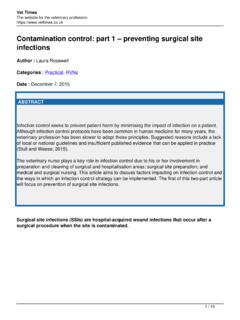Transcription of Managing pain with opioid analgesics in cats and dogs
1 Vet TimesThe website for the veterinary pain with opioid analgesics in cats and dogsAuthor : Karen WalshCategories : Companion animal, VetsDate : August 24, 2015 opioid analgesics are often the mainstay of perioperative pain management, but havebecome increasingly popular for longer term use at home and for chronic 1. Licensed opioids for use in animals in the the past few years a number of opioids have also been licensed for use in dogs and cats inthe UK (Table 1).This article aims to give the clinician the ability to choose the most appropriate opioid for aparticular case and and condition. While the choice of opioid medication only is discussed in thisarticle, it is highly unlikely this will be the only analgesic in use particularly for of the clinically used opioid analgesics are mu receptor agonists.
2 These drugs work at thespinal and supraspinal levels, as well as in some peripheral sites, such as the gastrointestinalsystem and joints if there is inflammation. pain perception and transmission is altered when thedrug binds to the effects are usually dose-dependent, although this will depend on the type of opioid forexample, partial agonist or full agonist (Panel 1).Receptor types 1 / 10 Panel 1. Agonist definitions Agonist: a drug that binds to a receptor and produces an agonist: a drug that binds to the receptor and is capable of producing the maximal effect in adose-dependent fashion for example, agonist: a drug that binds to the receptor, but will never produce a maximal effect, even ifthe dose is increased for example, : a drug that binds to the receptor, but does not produce any effect for example,naloxone.
3 Three receptor types are important for clinical pain management in veterinary peptide receptors (MOPs) these are located throughout the CNS in areasinvolved in sensory and motor function. They are the receptors most important in clinicalpain management and will alter the transmission of pain messages via C and A-delta effects include respiratory depression and gastrointestinal tract (GIT) peptide receptors (DOPs) these are less widely distributed and inhibit therelease of neurotransmitters in spinal and supraspinal sites. Side effects also includerespiratory depression and GIT peptide receptors (KOPs) these receptors also mediate analgesia andtend not to produce respiratory depression.
4 Side effects include diuresis, sedation opioidsThe following situations detail when to administer of a sedative protocolThe administration of an opioid in combination with a sedative agent will enhance the sedativeeffects and enable a reduction in sedative dose. The choice of opioid will depend on the intendedprocedure and the pain the patient is procedures 2 / 10 Butorphanol alone will sometimes result in adequate sedation to allow ultrasound and commonly, it can be combined with an alpha-2 agonist to produce profound sedation that willallow positioning for radiography and CT painful proceduresModerately painful procedures will require an opioid that produces a greater degree of would include buprenorphine and sedation produced can be as profound as that with a butorphanol combination, but in somepatients, higher doses of alpha-2 agonists may need to be administered.
5 However, a low dose ofketamine ( to 1mg/kg in dogs and 1mg/kg to 2mg/kg in cats) can be added to the protocolto improve the degree of sedation and muscle proceduresIf there is any question the patient may require surgical intervention then a full agonist opioidshould be chosen to optimise medication 3 / 10 Figure 1. Personal protective equipment required when administering transdermal reason to administer opioids in the premedication is provide preventive analgesia for elective procedures or start analgesic therapy inpatients already in enhance the sedative effects of drugs such as acepromazine and alpha-2 agonists in anattempt to decrease side effects with higher doses of sedatives and subsequently reducethe dose of maintenance agent to sustain may also be used as the sole agent for premedication where physical examinationindicates the patient may be suffering some underlying disease.
6 For example, in patients withcardiovascular disease, or conditions such as septic peritonitis, pethidine 3mg/kg to 5mg/kgintramuscularly or methadone to intravenously or intramuscularly, may beadequate as sole premedication prior to induction of drugs are commonly administered by injection in the pre-anaesthetic period. However, alicensed form of fentanyl in dogs exists that is administered transdermally, which will also helpimprove sedation when combined with acepromazine and alpha-2 fentanyl has an onset of action of two to four hours and analgesia should be provideduntil the drug becomes effective. Certain health and safety protocols should be followed whenapplying this drug and caring for the patient (Figure 1).
7 Intraoperative analgesiaThe opioid administered in the premed will, of course, be effective into the perioperative , there may be times when the drug is wearing off during the procedure or is not enough tominimise nociception and the patient may require additional is important to be mindful of the opioid administered preoperatively for example, pethidine willprovide analgesia for 69 minutes to 90 minutes and will probably require topping up when usedfor most procedures. Transdermal fentanyl should reach adequate blood levels in two hours to fourhours, but maintain the analgesia for four the dose of opioid has to be continually increased, the clinician should bear in mind anothergroup of analgesic drugs may be more appropriate in the particular case.
8 Using drugs fromdifferent groups of analgesics will help treat pain at different points in the pathway and lower therequired doses of analgesics such as bolus 4 / 10 Additional doses of methadone or morphine can be administered during the procedure. This can bea cheap and effective way of maintaining analgesia; however, it allows there to be peaks andtroughs of action. Shorter acting opioids, such as fentanyl, may be more appropriate in thissituation to treat short periods of increased stimulation for example, aligning a fracture. Careshould be taken when using morphine for top-ups as the drug can produce histamine releasewhen administered intravenously and it might be best to use methadone in this rate infusionShort-acting drugs, such as fentanyl or remifentanil, are best suited to continuous rate infuson(CRI).
9 These drugs have a rapid onset of action and a short duration that allows the effect to beswitched on and off when needed. It tends to smooth out the plane of anaesthesia and reduce theamount of inhalational agent required (Ueyama et al, 2009). A syringe driver should be used toallow accurate is licensed in dogs and so should be used in preference to other short-acting should be the facility to perform intermittent positive-pressure ventilation as respiration maybe compromised. The patient should also be monitored for bradycardia and the dose titrated toeffect. The inhalational agent will often be able to be decreased and this will help maintain bloodpressure within acceptable acting drugs, such as methadone and morphine, can also be administered as a CRI, but, asthey are longer acting than fentanyl, they are less easy to titrate to effect and are possibly moresuited to postoperative methods of administering opioidsOther methods of administering opioids include epidural and spinal administration.
10 Localadministration of opioids allows lower doses to be used with potentially less side 5 / 10 Figure 2. Epidural catheter in place. Image: A ( ) can be administered in saline at the lumbosacral junction to produceanalgesia up to the thorax. This can be administered as a single injection or continuing into thepostoperative period if an epidural catheter is placed (Figure 2). It should be diluted with sterilesaline to increase the volume and aid distribution. The advantages are:increased duration (12 to 24 hours) of action compared to systemic administrationlow dose ( ) compared to systemic administrationfewer side effects such as vomiting and respiratory depression (Valverde, 2008)Disadvantages are:more technically difficult than an intramuscular or intravenous injectionurinary retention and pruritus have been reported as side effects (Iff et al, 2012)SpinalSpinal or intrathecal administration can be achieved by injection or as a splash application during 6 / 10surgery.











